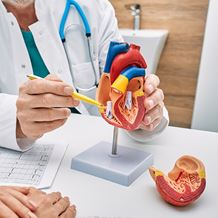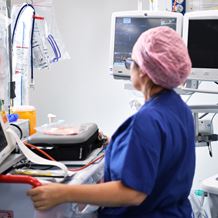
- Home
- Services
- Cardiac Services
- Procedures and Treatments
- Cardiac Tumour Removal
What is cardiac tumour removal?
Cardiac tumour removal is a surgical procedure to remove a growth from the heart. There are many different types of cardiac tumour. They can be either malignant (cancerous) or benign (non-cancerous), and they can cause painful symptoms and compromise the heart function. For non-cancerous tumours such as myxomas, the success rate for removal is very high. For more complex malignant tumours, complete removal is not always possible although a partial removal may relieve some symptoms. The procedure is typically performed as open-heart surgery. During the operation, the tumour is cut away and the heart is reconstructed where necessary.
What does it do?
The primary objective of cardiac tumour removal is to relieve symptoms and protect your heart health. Without surgery, heart tumours can cause related complications such as blood flow disruption, potential blood clots (embolism) and damage to the heart valves and structure. Once the cardiac tumour is surgically removed, it can be evaluated and diagnosed to assess whether any more treatment is required.
How does it work?
The type of cardiac tumour removal surgery will depend on the location and type of heart tumour present. The surgery works by cutting the tumour away from the healthy heart tissue, and repairing the heart structure left behind. Minimally invasive surgery may be available where the tumours are smaller and easily accessible. By removing the tumour, this relieves symptoms and reduces the risk of health complications.
Why is it performed?
If you have been diagnosed with a heart tumour, your doctor may recommend cardiac tumour removal to help relieve any symptoms and reduce health complications. Depending on the location and size of the cardiac tumour, you may experience:
- Noticeable symptoms such as chest pain, arrythmia, fatigue, fainting, shortness of breath, palpitations
- Increased risk of blood clot
- The tumour may be growing quickly
- Your heart cannot function efficiently
Procedure
Heart tumour removal is usually performed as open-heart surgery under a general anaesthetic. Your doctor will talk to you about the best approach for your individual condition.
- After receiving the anaesthetic, the heart is stopped and connected to a heart-lung bypass machine for the duration of the surgery
- The heart is accessed through the breastbone by making an incision in the chest
- The tumour is located and removed
- Any necessary reconstruction or repair is carried out, this may include valve repair or replacement
- A sample may be taken for biopsy
- The wound is closed and dressed
Recovery
Your stay in hospital will depend on the type of surgery performed and your general health coming into the operation, and this will vary by patient. Patients are encouraged to follow the individualised rehabilitation program as set out by your medical team which will include specific instructions around medication, activities, lifestyle adjustments and follow-up appointments. A complete recovery may take up to six weeks.
What's next?
If you have been experiencing heart-related symptoms, book an appointment with our cardiac services specialist today.
Our specialists in Cardiac Services
View all specialists





